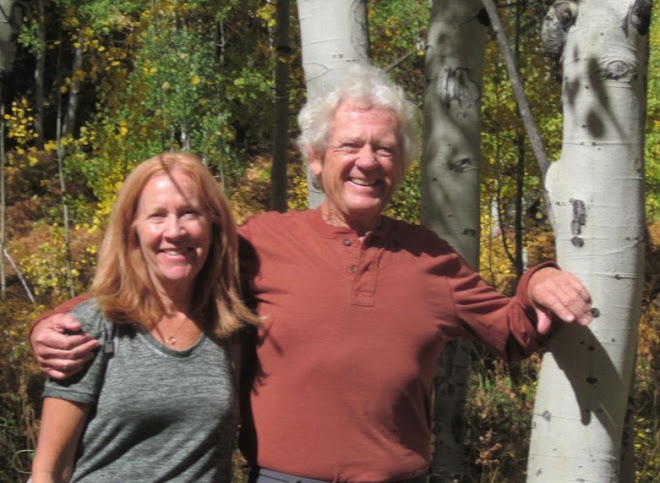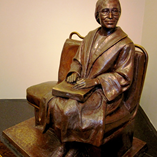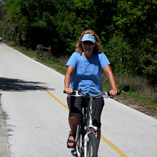In the two first weeks of April, we traversed the Southern States of Georgia, Alabama, and Mississippi, crossed great rivers as the Chattahoochee, Tennessee, and Mississippi, left the Appalachians behind and went on to the Ozarks. We were surprised at the pastoral, rolling hills full of horse ranches in Northeastern Alabama and along the banks of the Mississippi at Vicksburg. As always we found the people to be polite and gracious and friendly. They always use “sir” and “ma’am” when speaking to anyone. The thick southern accent is always fun to hear, even though at times it seems like a foreign language. In these two short weeks since leaving Florida, we saw the lush subtropical flora disappear into bleak, austere forests still donned in winter attire and then burst into spring blossoms and leaves. We saw redbud, wisteria, flowering dogwood, azaleas, camellias (Alabama State Flower), daffodils, tulips, irises, and roadsides full of Crimson Clover. Spring has sprung!
Along with springtime in this area also comes the chance of powerful storms. We were reminded of this with several tornado warnings, a tree that fell across the road just in front of us on the Natchez Trace, and from leftover damage on trails from the April 2011 storm (205 tornadoes touched down on one day alone, killing 349 people, and was the 4th deadliest in US history).
Our path this time seemed immersed in music history as well as Civil War and Civil Rights. We visited the Elvis Presley home in Tupelo Mississippi where he was born and raised until age 13. We saw a tribute to Hank Williams in his hometown of Montgomery Alabama. We visualized Alan Jackson cooling off in the Chattahoochee River (because it gets hotter than a hootchie-kootchie) near his home town of Atlanta. We can relate to the song of Randy Owen from the group Alabama, wanting to go back and be a mountain man near the Tennessee River every chance they get near their homes of Fort Payne, Alabama. We can see the hopes and dreams of Jazz musicians as the make their way up Highway 61 (the Mississippi Blues Highway) from New Orleans to Chicago hoping for a better life. And how can anyone spend any time here without occasionally catching oneself whistling “Dixie.” That tune was even one of Abe Lincoln’s favorites!
We did learn the origin of calling the South Dixieland. In the early 1800s, the Bank of Louisiana issued a $10 bill that was very popular and used extensively throughout the South - especially along the Mississippi River. One side was in English and the other in French. The French word for ten is Dix. Northern traders would return from the South with their pockets were full of Dixies. The South became known as the “Land of Dixies.” “Dixieland” was a song written to a march beat and for inauguration of Jefferson Davis. It became the unofficial song of the South during the Confederacy.
We learned that Coca-Cola, Nehi, and Royal Crown Cola were invented after the Civil War in Columbus Georgia (and that Coca-Cola was first bottled in Vicksburg, Mississippi.) Now it is more understandable why RC Colas and Moon-Pies were a staple at all NARCAR races.
We now understand that the Mississippi Delta Region is the fertile region along the Mississippi from Vicksburg to Memphis and not at the mouth in New Orleans.
President Teddy Roosevelt was once in Onward Mississippi hunting for bear. His guide and the guide’s hunting dogs cornered a bear and tied it to a tree for Mr. Roosevelt to shoot. Teddy Roosevelt refused, saying he could not shoot it since it was not in keeping with good sportsmanship. Based on this incident which received wide newspaper coverage, a Brooklyn woman, a stuffed-toy maker, made a stuffed bear dressed in TR’s hunting suit and sold it as a Christmas toy. And so, the Teddy Bear was born and the rest is history.
Since we mentioned Roosevelt, when we were in Hyde Park, New York and in Campobello, New Brunswick we learned that FDR spent time in Warm Springs, Georgia and, in fact died there in 1945. We were determined to complete our journey of FDR with a visit there. His “Little White House” was used from 1932-1945 and is a tiny cottage on beautiful grounds. All of the furnishings are authentic and exactly as they were in 1945 when he died there. It was called his “inspirational retreat.” It is surprisingly not luxurious and no President today would consider living like this. The museum has his “Unfinished Portrait” for which he was sitting when he had his cerebral aneurism. It also houses his 1938 Ford convertible with hand controls which he designed. There was also a nice film about his life in Warm Springs. The actual warm springs were 88 degrees and since FDR had heard of someone being cured of polio by the healing waters, he came here in 1924, before he was President, and breathed life into the community. He swam in the pools and played with the children and did normal things that would be unheard of today. When he learned that he was paying more for electricity for his tiny house there than he was in New York, he also brought cheaper electricity to the farmers. This may have been the basis of bringing electricity to rural areas as part of the New Deal. Many polio victims followed him there, seeking a cure. The pools today are empty and historic other than the small spring that you can touch. But there is a FDR Therapeutic Center nearby with healing pools, now used mostly for stroke victims or spinal injuries.
There were many Civil War battles fought in this area. We concentrated on seeing and learning about Andersonville, Vicksburg, and Montgomery.
Andersonville, Georgia, aka Camp Sumter, is a notorious Confederate Civil War POW camp renowned for mistreating prisoners. Pictures of emaciated men raised such an emotional outburst that the North called for retribution. The 30% death rate was about the same as the union POW camp in Elmira (aka Hell-mira), New York. At the peak, when cities were falling to Sherman and prisoners had to be moved, there were 45,000 Union prisoners in Andersonville, yet the camp was designed to hold only 15,000. The overcrowding, lack of food, and poor sanitary conditions led to a death rate up to 100+ per day. Nearly 13,000 died from dysentery, disease, starvation, or exposure. The unsanitary conditions and lack of clean drinking water created constant diarrhea and even gangrene. There was no shade and no trees so prisoners had makeshift tents for shade. Many tried to escape via tunnels but most all were recaptured. The top person in charge was Captain Wirz who was tried, convicted, and hanged for war crimes. This prison, for enlisted men only, existed for 14 months. The camp was an outdoor fenced area with a15 foot tall stockade wooden wall, and then another fence called the “deadline” another 19 feet inside of that. If any prisoner went past the deadline they were shot. (I wonder how many corporate deadlines would be past by today if that were the penalty). Wirz tried to get more food and space, but the Confederacy was severely losing the war at that time, and didn’t have enough supplies for themselves. He tried to negotiate for prisoner exchanges to reduce the number, but Grant and Lincoln refused. He offered to return prisoners if the North would send ships for them- none ever arrived. Sherman, in his march to the sea, did not to take the resources to liberate the prison. In spite of this “shared” set of circumstances, Wirz was blamed alone. His grave marks him as a martyr, which he probably was. There were six “Raiders” who were basically prison bullies and thieves since there were no union officers to keep order, and the guards were just teenagers (all older men were fighting the war). The prisoners, with Wirz’ backing, captured the raiders. All six were tried by their prisoner peers and hanged. They are buried separately off by themselves in disgrace at the National Cemetery there. The headstones are mere inches apart since the soldiers were buried shoulder to shoulder in trenches, not in boxes, since there were so many deaths each day. More soldiers were POWs in the Civil War than in World War II. There is, appropriately, a National POW museum at this location honoring POWs from all wars and is the repository for POW memorabilia.
Vicksburg, Mississippi, has the largest National Cemetery in the US for union soldiers with 17,000, of which 13,000 are unknown. Vicksburg was important to the Union in order to control the Mississippi River and therefore the southern states that depended on it. It was “the key” according to Lincoln. Grant had 4 or 5 attempts to take Vicksburg and was rebuffed each time. Vicksburg has steep, large slopes between the city and Grant’s attacks from the east and was therefore difficult to attack. It did not need to be a walled city to require a siege. After taking Jackson MS, Grant tried again in what became known as the siege of Vicksburg. This last attempt, after 46 days of siege, was to starve the city into submission. Confederate General Pemberton surrendered Vicksburg on July 4 hoping for leniency [Interesting that Mississippi wouldn’t celebrate the July 4th holiday again until 1907.] Gettysburg’s defeat ended the day before, on July 3rd and these two losses were the turning point of the war, even though fighting continued for 21 more months.
Vicksburg was also a POW exchange point. On Apr 24, 1865, over 2300 Union soldiers from the prisons in Andersonville (& Cahaha, Alabama) left Vicksburg on the steamer Sultana headed upriver for home. Three nights later near Memphis, the overloaded boat exploded and over 1800 died. It is America history’s biggest maritime disaster but with the surrender of both Lee & Johnston’s Confederate armies, and the assassination of Lincoln in Apr 1865, the incident made little news. It remains a little known tragedy of the Civil War years.
Montgomery, Alabama was originally the capital of the Confederacy (before moving to Richmond.) Jefferson Davis was sworn in as the president of the Confederacy on its Capitol’s front steps in 1861 and lived nearby in the First Whitehouse of the Confederacy,
Montgomery is also a significant contributor to the history of civil rights. It was here that Rosa Parks refused to give up her seat on the bus, leading to the bus strike and the changing of the custom (not law) that blacks had to sit in the back, or give up their seat to a white person. Martin Luther King was chosen to be the leader of the bus boycott. His home was bombed and he preached non-violence in response. It was the final push to him to fully commit to the Civil Rights movement (they call this “The Epiphany”.)
MLK’s first and only church where he was pastor is within sight of the confederate capitol and has been renamed “Dexter Avenue King Memorial Baptist Church.” The basement is where the effective bus boycott plan was derived. The church is only one block from the Capitol building, on famous Dexter Avenue, which is also the path for the famous Selma-to-Montgomery march, as well as the inaugural parade route for Jefferson Davis. Dexter Avenue has the Capitol on one end and the Court Square Fountain at the other end, where slaves used to be sold, and where the order to fire on Ft Sumter originated. The juxtaposition of being the cradle of the Civil Rights Movement and the capital of the Confederacy – only one block apart – both began in Montgomery – is amazing.
This was a full two weeks in the South! This is such a wonderful country and we always enjoy seeing new things, meeting new people, and learning about the history. Until next time, Happy trails to you!














































